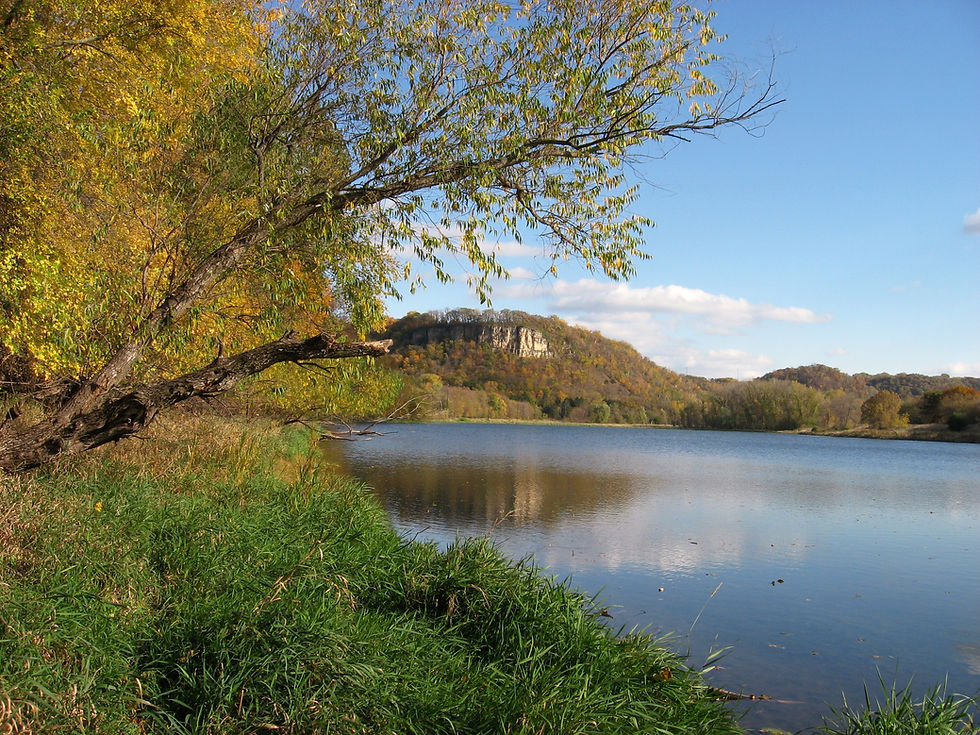Spring Arrives
- wacoutanaturenotes
- Apr 8, 2025
- 3 min read
Despite the fickle yet somewhat normal March and early April weather, spring has been set in motion by the return of numerous migrants to our local environment.
Even year around residents are getting in on the action. I guess the three snows on a robin's tail doesn't apply this year.

As I mentioned in my last post, nesting bald eagles incubate their eggs primarily during the month of March. By the first week of April, eaglets are beginning to hatch.
I took this photo on April 5, 2020. If you look closely, the newly hatched down covered eaglet is in front of the adult. To the left of both birds are the partial remains of a northern pike and freshwater drum. They will provide future nourishment for the new arrivals.
Our Wacouta neighbor, Sue Milbright, has a majestic bur oak tree located in front of her home. Over the years, local eagles find the upper reaches of this tree a desired place to land and rest for extended periods of time.
Her son, Michael, recently hoisted on a heavy cord a ring security camera to a height of 30 feet to capture possible eagle activity.
Soon after securing the camera, a pair of eagles took advantage of the photo opportunity. Wouldn't you love to know the details of their conversation? Make sure you have your audio turned up to hear them.

Around the 3rd week of March, I began to observe small flocks of wood ducks flying overhead in our neighborhood. These early spring migrants are without a doubt the most colorful of our resident waterfowl.
These ducks can be observed feeding along the water's edge in the wetlands or occasionally resting up in a large tree. In the fall of the year, ripe acorns are a favorite food.

The first few weeks of the nesting season will find the female wood duck checking out nesting cavities in dead trees or artificial nesting boxes. Sometimes she can become rather fussy. The decor has to be just right.

Once a suitable site meets her approval, she will lay one egg a day until her clutch of 10 to 12 eggs in complete. At that time, incubation will commence.
After approximately 32 days, all eggs will hatch within a few hours. The next morning with her urging and calling, the ducklings will jump (they can't fly yet) out of the nest. After gathering her ducklings together, she will lead them to the nearest water.

With high temperatures in the 70's for March 27th, I decided to take my solo canoe out for it's maiden voyage in 2025 and explore Wacouta Bay. My first exciting observation was a pair of sandhill cranes.
On March 10th, I started to hear the first unique calls of the cranes this spring. For the next ten days, small flocks of cranes were migration north at extreme heights over Wacouta.

On March 27th, the level of the Mississippi River was 3.2 feet. I was soon to discover at that level there was barely a foot of water across the entire bay.
At such a low level, conditions were favorable for numerous flocks of Canada geese and dabbling ducks. The different species of ducks I observed this morning included mallards, green-winged teal, blue-winged teal, northern shoveler, bufflehead, hooded mergansers and wood ducks.

Surprisingly, I even encountered a Canada goose on it's nest. Unfortunately, with the 2.5 inches of rain we experienced on March 29th, the river rose a couple feet and no doubt flooded the nest. Over the years, the most successful goose nests I have observed in the backwaters have been built on large floating logs or trees.

Without a doubt, one of the most unusual observations that morning was a newly constructed beaver scent mound. This nearly two foot high mound was built to mark their territory.
These mounds are constructed from mud with beaver castoreum mixed in. Adult beavers will defend their territory by attacking any beaver from outside their family.
You may or may not want to know castoreum is used extensively in making some perfumes!




Comments